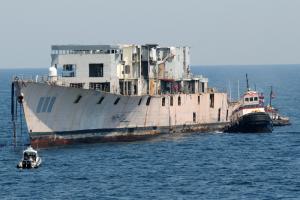Ex-Navy destroyer Radford sunk off Indian River Inlet

Culminating the country’s first multistate artificial reefing effort, the U.S. Navy destroyer ex-USS Arthur W. Radford was sunk Aug. 10 in 135 feet of water off Indian River Inlet. The decommissioned warship’s carefully staged sinking was witnessed by former crew members and state and federal officials aboard the Cape May-Lewes ferry M/V Delaware, chartered for observing the Radford as she descended at approximately 3:30 p.m. to her final resting place as an artificial reef.
The Radford, her hull spanning 563 feet and the longest vessel ever reefed in the Atlantic, was sunk at the Del-Jersey-Land Inshore Reef site located 26 miles southeast of the Indian River Inlet. The Del-Jersey-Land reef is a collaborative effort of the three states cited in its name - Delaware, New Jersey and Maryland – and lies equidistant from fishing ports in Indian River, Cape May, N.J., and Ocean City, Md.
Gov. Jack Markell sent a message of thanks to the ex-Radford’s crew members for their service: “This ship and its crew have been all over the world protecting our country. Now, the Radford’s new mission will bring people from across the nation and other parts of the world to our region.
“Our artificial reefs bring in thousands of fishing and dive trips annually - and that brings in something else we like to see in our region - jobs,” Markell continued. “We’re excited and thankful for the successful collaboration between Delaware, New Jersey and Maryland. I’d also like to thank the Navy for their assistance. Through this partnership, this ship represents a step forward in protecting our environment, promoting incredible biodiversity, and providing special recreation opportunities for families and explorers.”
“Beyond benefiting marine life, the sinking of the Radford at the Del-Jersey-Land site is a tremendous boost to Delaware’s coastal economies through recreational fishing and diving,” said Delaware Department of Natural Resources and Environmental Control Secretary Collin O’Mara. “This extraordinary reefing of the Radford strengthens our marine resources and enhances Delaware’s internationally recognized network of 14 artificial reefs.”
“The sinking of the ex-Navy destroyer, USS Arthur W. Radford, will allow it to continue to serve our country far after it was decommissioned,” said Sen. Tom Carper, a former naval flight captain. “By adding the former warship to the artificial reef off the coast of Delaware, the Radford will help bolster the region’s coastal economies and make a great example of taking something old and turning it into something new.”
“Delaware has always been a state of firsts, and I’m pleased that we can be part of America’s first multistate artificial reefing effort,” Sen. Chris Coons said. “I applaud the collaborative undertaking of Delaware, Maryland, New Jersey and the U.S. Navy to sink the Radford off our states’ shores in a way that is not only safe for the environment, but beneficial to it. The Radford will provide a habitat for marine wildlife to flourish, helping to attract tourism and enhance revenue to Delaware’s coastal region.”
“I’d like to congratulate all of the officials and workers in Delaware, New Jersey, and Maryland who helped make today possible,” said U.S. Rep. John Carney. “The establishment of this artificial reef is a tremendous example of how all of our states can work together in the best interests of our region. The Radford is an exciting addition to Delaware’s artificial reef program, and I’m sure it will benefit those who enjoy fishing and diving, as well as the marine life off of our coastline, for many years to come.”
After the Navy’s announcement of the Radford’s availability for reefing in January 2008, the ship underwent 14 months of preparation by American Marine Group, a Virginia-based marine towing, salvage and reefing contractor. The company, which has extensive experience reefing ships in the Atlantic, cleaned and prepared the Radford to Environmental Protection Agency specifications. Much of her armored hull and other nautical equipment were recycled for reuse. Funding for the ship’s transportation, cleanup, preparation, sinking and monitoring was shared among the three states and the Navy. Delaware’s portion came from the Sportfish Restoration Program that includes federal excise taxes on fishing and boating equipment in the state.
The destroyer, named for Navy Admiral Arthur W. Radford, who served as the commander in chief of the U.S. Pacific Command and chairman of the Joint Chiefs of Staff, was commissioned in 1977 and decommissioned in 2003.



























































